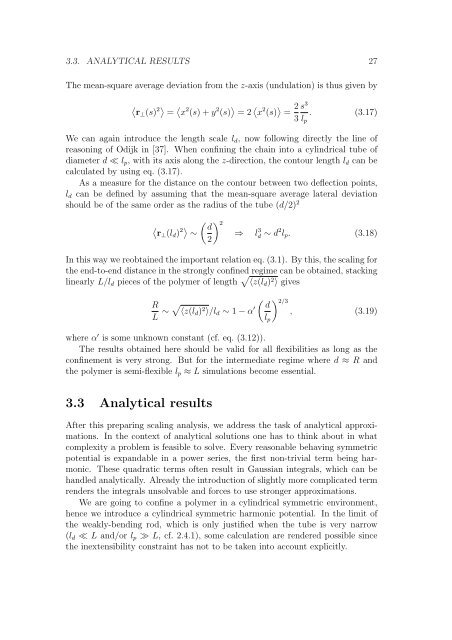Polymers in Confined Geometry.pdf
Polymers in Confined Geometry.pdf
Polymers in Confined Geometry.pdf
You also want an ePaper? Increase the reach of your titles
YUMPU automatically turns print PDFs into web optimized ePapers that Google loves.
3.3. ANALYTICAL RESULTS 27<br />
The mean-square average deviation from the z-axis (undulation) is thus given by<br />
r⊥(s) 2 = x 2 (s) + y 2 (s) = 2 x 2 (s) = 2<br />
3<br />
s 3<br />
lp<br />
. (3.17)<br />
We can aga<strong>in</strong> <strong>in</strong>troduce the length scale ld, now follow<strong>in</strong>g directly the l<strong>in</strong>e of<br />
reason<strong>in</strong>g of Odijk <strong>in</strong> [37]. When conf<strong>in</strong><strong>in</strong>g the cha<strong>in</strong> <strong>in</strong>to a cyl<strong>in</strong>drical tube of<br />
diameter d ≪ lp, with its axis along the z-direction, the contour length ld can be<br />
calculated by us<strong>in</strong>g eq. (3.17).<br />
As a measure for the distance on the contour between two deflection po<strong>in</strong>ts,<br />
ld can be def<strong>in</strong>ed by assum<strong>in</strong>g that the mean-square average lateral deviation<br />
should be of the same order as the radius of the tube (d/2) 2<br />
r⊥(ld) 2 ∼<br />
2 d<br />
2<br />
⇒ l 3 d ∼ d 2 lp. (3.18)<br />
In this way we reobta<strong>in</strong>ed the important relation eq. (3.1). By this, the scal<strong>in</strong>g for<br />
the end-to-end distance <strong>in</strong> the strongly conf<strong>in</strong>ed regime can be obta<strong>in</strong>ed, stack<strong>in</strong>g<br />
l<strong>in</strong>early L/ld pieces of the polymer of length 〈z(ld) 2 〉 gives<br />
R<br />
L ∼ 〈z(ld) 2 〉/ld ∼ 1 − α ′<br />
d<br />
lp<br />
2/3<br />
, (3.19)<br />
where α ′ is some unknown constant (cf. eq. (3.12)).<br />
The results obta<strong>in</strong>ed here should be valid for all flexibilities as long as the<br />
conf<strong>in</strong>ement is very strong. But for the <strong>in</strong>termediate regime where d ≈ R and<br />
the polymer is semi-flexible lp ≈ L simulations become essential.<br />
3.3 Analytical results<br />
After this prepar<strong>in</strong>g scal<strong>in</strong>g analysis, we address the task of analytical approximations.<br />
In the context of analytical solutions one has to th<strong>in</strong>k about <strong>in</strong> what<br />
complexity a problem is feasible to solve. Every reasonable behav<strong>in</strong>g symmetric<br />
potential is expandable <strong>in</strong> a power series, the first non-trivial term be<strong>in</strong>g harmonic.<br />
These quadratic terms often result <strong>in</strong> Gaussian <strong>in</strong>tegrals, which can be<br />
handled analytically. Already the <strong>in</strong>troduction of slightly more complicated term<br />
renders the <strong>in</strong>tegrals unsolvable and forces to use stronger approximations.<br />
We are go<strong>in</strong>g to conf<strong>in</strong>e a polymer <strong>in</strong> a cyl<strong>in</strong>drical symmetric environment,<br />
hence we <strong>in</strong>troduce a cyl<strong>in</strong>drical symmetric harmonic potential. In the limit of<br />
the weakly-bend<strong>in</strong>g rod, which is only justified when the tube is very narrow<br />
(ld ≪ L and/or lp ≫ L, cf. 2.4.1), some calculation are rendered possible s<strong>in</strong>ce<br />
the <strong>in</strong>extensibility constra<strong>in</strong>t has not to be taken <strong>in</strong>to account explicitly.













